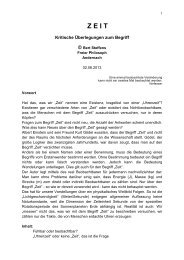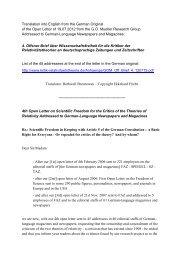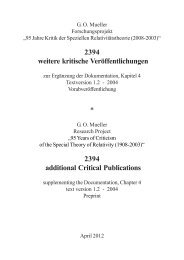1. The Need of New Approaches - Kritische Stimmen zur ...
1. The Need of New Approaches - Kritische Stimmen zur ...
1. The Need of New Approaches - Kritische Stimmen zur ...
Create successful ePaper yourself
Turn your PDF publications into a flip-book with our unique Google optimized e-Paper software.
Chapter 9: <strong>The</strong> Thought Experiment<br />
778 / 2005-02-02 - DEUTSCHER BUNDESTAG, Committee for Culture and the Media. Berlin.<br />
CD-ROM <strong>1.</strong>2 with printout <strong>of</strong> 93 sample pages, 2nd Progress Report.<br />
Extract:<br />
“Should the committee prefer not to take a stand against the problems uncovered by our documentation because<br />
“one can’t do anything about it”, because everything must remain as it is - which we, however, do not believe - we<br />
would at least like to have one <strong>of</strong> our questions responded to publicly:<br />
Why may 95 years <strong>of</strong> criticism <strong>of</strong> the special theory <strong>of</strong> relativity (1908-2003) be suppressed?<br />
For the sake <strong>of</strong> simplicity, the question can be also be subdivided into two question subsections:<br />
May 95 years <strong>of</strong> criticism <strong>of</strong> the special theory <strong>of</strong> relativity (1908-2003) be suppressed? And if so: For how<br />
long?<br />
(...)<br />
Appendix: Short Discussion <strong>of</strong> the Standard Presentation <strong>of</strong> the Relativists<br />
According to the conviction <strong>of</strong> the relativists, their creed can be stated roughly as it was again recently<br />
formulated in a large German newspaper (29.9.02), and as one finds it in all presentations <strong>of</strong> the theory (newspaper<br />
title and author therefore play no role):<br />
“An important experiment <strong>of</strong> the modern age was, for example, the attempt to prove the existence <strong>of</strong> the ether.<br />
This was conceived by physicists as being an ideal substance that served as a carrier medium for the spreading <strong>of</strong><br />
light waves. Towards the end <strong>of</strong> the 19th century the physicist Albert Michelson and the chemist Edward Morley<br />
designed an arrangement <strong>of</strong> mirrors that reflected beams <strong>of</strong> light in various directions. In the ether these should<br />
have propagated differently. But regardless <strong>of</strong> the path travelled by the light - the time difference between them was<br />
always zero. Nor could this be altered, despite the precision <strong>of</strong> the measurements.<br />
<strong>The</strong> Michelson-Morley experiment at that time shocked the foundations <strong>of</strong> physics. <strong>The</strong>reafter there was no<br />
longer an ether, no absolute space and, as Albert Einstein later added, not even an absolute time. In his famous<br />
formula e=mc² there is now only one constant: the speed <strong>of</strong> light.”<br />
Everything in this description - except for the name <strong>of</strong> the researchers involved - is incorrect. <strong>The</strong> false claims as<br />
to the interferometry experiment undertaken by Michelson and Morley are particularly grotesque:<br />
(1) <strong>The</strong> experiment was carried out incompletely in 1881 and 1887, which is why it could not give the findings<br />
sought.<br />
(2) <strong>The</strong> supposed null result was never obtained. Already with the first experiment in 1881 with a first-time (!)<br />
development, i.e. with a technically still fully undeveloped instrument, the minor fluctuations showed no statistically<br />
uniform distribution <strong>of</strong> the deviations, but a clear periodicity. During the first repetition in 1887, with a technically<br />
improved device in an improved arrangement, differences in running times were measured that gave an ether drift<br />
<strong>of</strong> about 8.8 km/sec. Later repetition in 1902, 1904 and 1905 gave values <strong>of</strong> around 8.7 km/sec, whereas 1921,<br />
1924, 1925 and 1927 gave values <strong>of</strong> between 9.3 and 1<strong>1.</strong>2 km/sec.<br />
(3) <strong>The</strong>se results, which can be read in the source texts, did not devastate any foundations <strong>of</strong> physics, but have<br />
only been denied through the spreading <strong>of</strong> the claim <strong>of</strong> the “eternal null result”. Since then the denial has hindered<br />
research. Furthermore, the following is incorrect:<br />
(4) <strong>The</strong> assumption <strong>of</strong> an ether was regarded by Albert Einstein in 1905, according to his own statement, as not<br />
needed. In 1920 the same Albert Einstein, in his lecture in Leiden, declared the existence <strong>of</strong> an ether as again being<br />
essential. No reason has ever been given for a rejection <strong>of</strong> the ether, and thereby <strong>of</strong> absolute space.<br />
(5) <strong>The</strong> relativity <strong>of</strong> time claimed by Albert Einstein was given up by the astronomers around 1930. In 1969 P.<br />
Janich showed that the concept <strong>of</strong> time was something normative, given by man, and this proto-physical setting<br />
cannot logically be subsequently altered by pace disturbances or the hand settings <strong>of</strong> clocks constructed on the basis<br />
<strong>of</strong> this normative setting.<br />
(6) <strong>The</strong> famous formula e=mc² does not describe any mass transformation into energy, or any relativistic<br />
procedure and was not discovered by Albert Einstein, but by other scientists before him. Moreover, Albert<br />
Einstein’s own derivation <strong>of</strong> the formula is circular, i.e. it has no pro<strong>of</strong> quality.<br />
<strong>The</strong> detailed justification <strong>of</strong> the criticism and the pro<strong>of</strong> <strong>of</strong> the sources can be found in Chapter 2 <strong>of</strong> our documentation / text<br />
version <strong>1.</strong>2: the error groups A (ether) on pp 41-48, D (time) on pp 61-75, K (mass-energy designation) on pp 109-112.<br />
2012<br />
103<br />
G. O. Mueller: STR





